JUST LET ME BE.


JUST LET ME BE.
More Posts from Oracleofthepast and Others
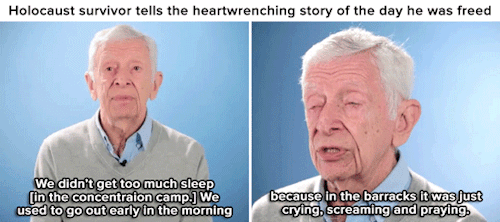
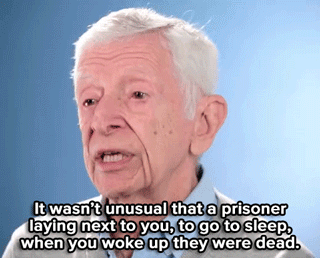
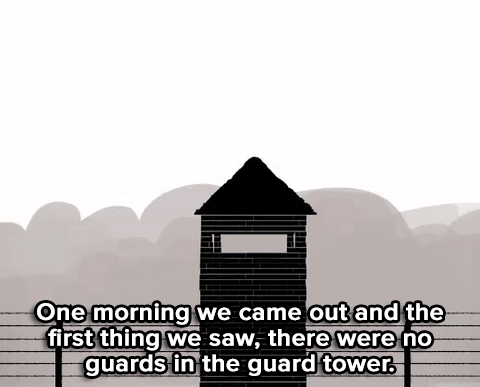
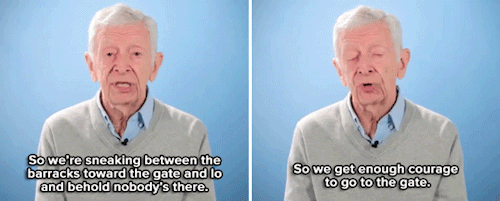

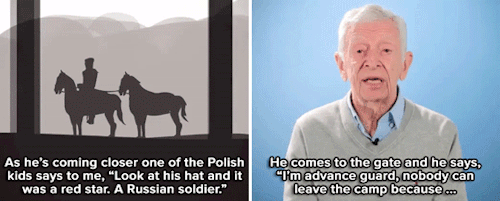
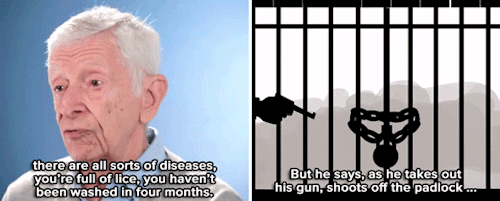
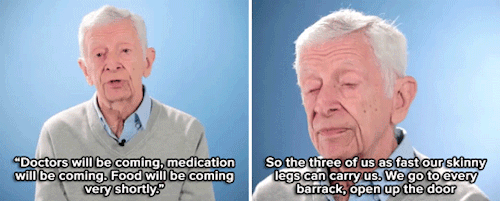

Watch: The most wonderful moment of joy came when he entered a Nazi guard bungalow.

Fearing such hits as “Poisoning Pigeons in the Park,” “National Brotherhood Week,” “The Masochism Tango,” “The Element Song,” “Be Prepared,” and “Lobachevsky”
Imagine: Its 2025. You're getting pulled over. A community representative approaches to let you know you have a taillight out. They don't need your license and registration, they don't write you a fix-it ticket. You're back on the road in less than five minutes. You swing by the store and grab a new light, not because you're afraid of what the city will do to you, but because you respect your community and know that having all your lights working is part of the driving privilege.
Your neighbors got into a loud spat a few weeks ago and without fear or hesitation, called a domestic assistance number. A counselor arrived and was able to talk the couple down and suggest solutions for their disagreement. No one was hurt, the kids participated in the discussion, and it's been quiet ever since.
Your friend has been struggling with addiction and you fear they might be a danger to themselves or others. You call a substance abuse specialist and they talk you through ways to help your friend get treatment. They offer to send an agent out to speak with your friend directly and provide information on harm reduction centers in your area.
Black and brown people are no longer being exploited through tickets and fines to pay for police. Trust is slowly being fostered in the community.
Teachers are being paid a living wage and students are being given more time, attention, and education. Books are up to date and classrooms are optimized to keep up with technology.
Trump is out of office.
It’s been a very long time since the name of a murdered black person was used as a hashtag.
Casual racism is no longer tolerated. The KKK has been classified as a terrorist organization. The Confederate flag isnt flown and has been removed from any official state flags or insignias. Most Confederate monuments have been taken down and placed in storage or museums.
You trust the investigation force to deal with crime the same way you trust firefighters to put out fires.
That's what 'defund the police' looks like. What we've seen in the last few weeks shows how overreaching and power-drunk many officers are. We asked too much of them and then called them heroes despite evidence to the contrary. We let them think that they could get away with anything, including murder. Its time for change.
Copied and pasted.
My face is having uncontrollable spasms. Great. It hurts really, really, really bad.
I think part of why I have trouble explaining pain to the doctor is when they ask about the pain scale I always think “Well, if someone threw me down a flight of stairs right now or punched me a few times, it would definitely hurt a lot more” so I end up saying a low number. I was reading an article that said that “10” is the most commonly reported number and that is baffling to me. When I woke up from surgery with an 8" incision in my body and I could hardly even speak, I was in the most horrific pain of my life but I said “6” because I thought “Well, if you hit me in the stomach, it would be worse.”
First Aid Basics
I just got certified in CPR and First Aid last month with the American Heart Association. I wanted to share this information with you, because a lot of what we see on TV is not at all accurate as to what you’re supposed to do to actually help someone. Here are some of the topics that were covered:
First Aid Basics
Here are the steps you should follow when addressing a situation where a person may be injured/unconscious:
Check to make sure the scene is safe- you are no help to anybody if you also get hurt
If the person is responsive: “Are you okay?”
If they are unresponsive, hit their shoulders hard and yell: “Are you okay?” to see if you can rouse them
Phone 911 and put the phone on speaker (you can delegate this task to somebody else if you’re not alone)
Have somebody get a First Aid kit (don’t leave the person if you’re by yourself unless the 911 operator tells you to)
Is the person conscious? Unconscious?
Check them for any obvious signs of injury
Check them for medical jewelry
Remember
Time is of the essence! Be decisive and confident.
Don’t be afraid to call for help and assign people tasks
You can only perform CPR on a flat service. If a person needs CPR and is on a bed or in a chair, move them to the floor immediately. Don’t worry about hurting their head or anything, if they don’t get CPR immediately, their life expectancy is significantly less. (See my CPR post for full details)
Do not move the person unless the area they’re in is unsafe. If you have to move the person, drag them by their clothes and pull them to safety.
Adult Choking
There are both mild and severe cases of adult choking. In a mild case, the person choking will be able to make a sound or cough loudly. Typically these cases resolve themselves.
Ask: “Are you choking? Can I help you?”
If the person cannot make a sound or cough in response, they are suffering from severe choking.
Walk around back of the person and put your arms around them
Make a fist with your dominant hand
Place your fist slightly above the belly button and below the chest bone.
Grasp the fist with your other hand
Give quick upward thrusts
If the person is overweight or pregnant, put your arms around the person’s armpits.
If you are unsuccessful in removing the blockage, the person will quickly become unresponsive. You will need to perform adult CPR and call 911.
After chest compressions (see above link) check person’s mouth to see if the thing they choked on is visible. If it is visible, remove it. Never going digging around in someone’s mouth.
Amputation
Call 911 and put the phone on speaker
Get a First Aid kit
Both these steps can be delegated to someone else if they’re around
Put gauze on the wound and apply pressure until the bleeding stops
Do not remove the gauze if it’s bled through- this will remove any blood clots that have formed.
If the gauze is bled through, add more gauze on top and keep applying pressure until the bleeding stops
Clean the amputated part with water
Warp the amputated part with dressing
Put the amputated part in a small plastic bag
Get a larger plastic bag and fill it with equal parts ice and water
Put the small plastic bag inside the large plastic bag
Label the bag with person’s name and time of the injury
Asthma (How to Operate an Inhaler)
People diagnosed with asthma will typically be aware of it and may have an inhaler on them. If someone has an asthma attack:
Ask them: “Are you okay? Do you need your inhaler?”
The person will probably be able to give some sort of indication in response
If they need their inhaler:
Locate the inhaler
Put the medicine (metallic capsule pictured below) in the inhaler if it is not already in there, it will click into place
Shake the inhaler to activate the medicine
Attach the mouth piece if it’s unattached (not all inhalers have one, it is not pictured below)
Remove the cap (cap is darker blue piece pictured below)
Have the person put their head back
Put the inhaler in the person’s mouth
Push down on the canister and have them breathe out slowly
They should begin to feel relief immediately, but you should still have them sit down and take it easy for a while
Call 911 if they are still having difficulty breathing after the inhaler has been administered

Bee Sting
Usually bee stings present only mild irritation and pain. If the person stung has a severe allergic reaction, you will need to call 911.
Get a first aid kit
Scrape away the bee stinger and venom sack using a credit card or something similar in nature
Wash the affected area with lots of soap and running water
Wrap a bag of ice in a towel and place it over the affected area for 20 minutes or until the pain is gone
Watch the person for up to 30 minutes for signs of an allergic reaction
Call 911 if they present any classic allergy symptoms
Bleeding from Nose
Have the person lean their head forward
Get a First Aid kit
Or have someone else get one
Have the bleeding person apply pressure to the bridge of their nose using gauze from the First Aid kit
Do not remove the gauze if it’s bled through- this will remove any blood clots that have formed.
If the gauze is bled through, add more gauze on top until the bleeding stops
Call 911 if the bleeding lasts longer than 15 minutes
Heat Cramps/Dehydration
Can lead to heat exhaustion! These typically happen when someone is dehydrated and tries to do lots of physical activity.
Have the person sit down and cool off
Have them drink something with sugar and electrolytes
Water will work in a pinch but sugary drinks and gatorade are preferred
Heat Exhaustion
Call 911 and put the phone on speaker
Have the person lie down
Cool the person by pouring water on them or wetting them with wet cloths until they begin to act normally
Have them drink something with sugar and electrolytes
Water will work in a pinch but sugary drinks and gatorade are preferred
Wait with them until help arrives
Opioid Overdose
My instructor said that these will often happen in an unsafe or an isolated environment. Always check to make sure that the scene is safe- look out for needles.
Naloxone is used to revive people who have overdosed on opioids. If you find someone who has overdosed on opioids you happen to have naloxone on you and know how to administer it, the American Heart Association recommends that you use it instead of waiting for help to arrive.
Responsive:
Yell for help
Call 911 and put the phone on speaker
Wait with the person until help arrives
Unresponsive
Yell for help
Call 911 and put the phone on speaker
Perform five cycles of adult CPR
Wait for help

Seizure
Seizures are abnormal electrical activity in the brain. Typical seizure symptoms: spasms, muscle rigidity, and unconsciousness. Seizures typically last between 60-90 seconds before the person gains consciousness.
Do NOT touch the person who is having a seizure
Do NOT put anything in their mouth
Call 911 and put the phone on speaker
If there are people around, ask them to get a First Aid kit while you wait with the person having the seizure
Don’t leave the person having a seizure if you are alone
Move objects away from the person having the seizure so that they don’t knock into them
If possible, place a small towel/pad underneath the person’s head
If the person starts vomiting, turn them over on their side so that they don’t choke
If possible use gloves and an eye mask from a First Aid kit to avoid exposure to bodily fluids
After they come to, they may be bleeding from the mouth.
Use gauze from a First Aid kit to stop the bleeding
Have them apply pressure with the gauze until the bleeding stops
Stay with the person until help arrives
Splints
Splints should be significantly longer than the injured area. They’re used to constrict movement, so the person is injured should not be able to move freely once the splint is applied. Splints are use to treat broken/dislocated bones. It’s very difficult to tell if a bone is actually broken or just dislocated, so don’t worry about it and just splint the thing.
Call 911 and put the phone on speaker
Get a First Aid kit
Both these steps can be delegated to someone else if they’re around
Put on gloves/eye glasses from the First Aid kit to avoid contamination from bodily fluids
Cover exposed wound area with gauze
Do not remove the gauze if it’s bled through- this will remove any blood clots that have formed.
If the gauze is bled through, add more gauze on top until the bleeding stops.
Place a strip of rigid material underneath the injured area
Use gauze/dressing from the First Aid kit to secure the splint by wrapping material above and below the injured area
Never tie material directly over the injury
Have the person stay as still as possible until help arrives

Stroke
Strokes are caused from blockage/bleeding from things like blood clots. Typical signs of a stroke: face drooping (or numbness), arm weakness (or numbness), and speech difficulty. There is nothing much you can do except wait with the person and try to make them comfortable until help arrives.
Call 911 and put the phone on speaker
Note the time that the stroke symptoms began (this will help hospital technicians)
Stay with the person until help arrives
Tourniquets
Some First Aid kits will come with a pre-made tourniquet. If your kit does not have a tourniquet you can make one fairly easily. Tourniquets should only be used for injuries where the person is squirting blood. No squirting blood? Use a splint.
Call 911 and put the phone on speaker
Get a First Aid kit
Both these steps can be delegated to someone else if they’re around
Put on gloves/eye glasses from the First Aid kit to avoid contamination from bodily fluids
Fold cloth or a bandage so that it’s long and an inch wide
Wrap the the bandage/cloth two inches above the wound
Never apply a tourniquet bandage/cloth on a joint (like elbows or knees).
Find a small stick
Place the small stick atop the cloth/bandage and tie it there
You can now turn the small stick to tighten the cloth/bandage
Have the injured person lay down and try to move as little as possible
Do not remove the tourniquet- even if the bleeding stops.
Wait until help arrives.

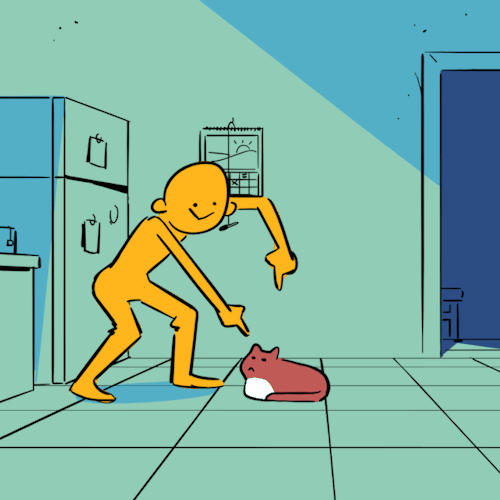
Bothering the beast
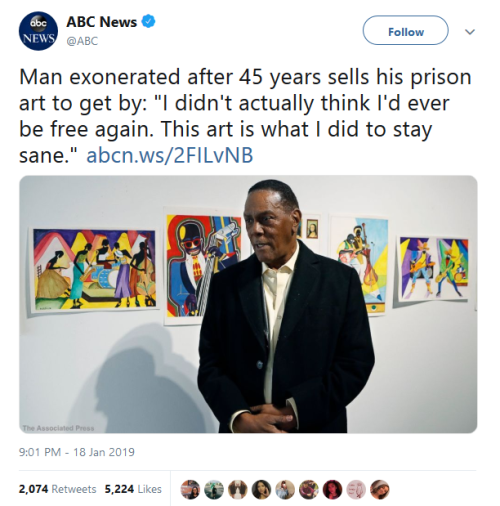





Can we support him please?!



A New Hampshire Republican State Representative anonymously created the “Red Pill” subreddit.
Wow.

Benadryl, when taken in high volume, causes hallucinations so vivid they are indistinguishable from reality. - weird, interesting & funny facts
I thought all Denny’s were like that?
Your local Denny’s is a hotspot for the mysterious things of all existence. Cryptids manifest, realities warp, and unfathomable, unexplainable phenomena occur on the property. Describe your time working there.
-
 lilsilly02 liked this · 1 week ago
lilsilly02 liked this · 1 week ago -
 notmyproblem777 liked this · 2 weeks ago
notmyproblem777 liked this · 2 weeks ago -
 leramarchukspyro liked this · 2 weeks ago
leramarchukspyro liked this · 2 weeks ago -
 1930sdarlin liked this · 2 weeks ago
1930sdarlin liked this · 2 weeks ago -
 starlightcycle reblogged this · 3 weeks ago
starlightcycle reblogged this · 3 weeks ago -
 coin-goofball liked this · 3 weeks ago
coin-goofball liked this · 3 weeks ago -
 fennec-fox21 liked this · 3 weeks ago
fennec-fox21 liked this · 3 weeks ago -
 orangebug13 liked this · 4 weeks ago
orangebug13 liked this · 4 weeks ago -
 steampunkmarquise liked this · 4 weeks ago
steampunkmarquise liked this · 4 weeks ago -
 silvergryphonart reblogged this · 4 weeks ago
silvergryphonart reblogged this · 4 weeks ago -
 lycalpha reblogged this · 4 weeks ago
lycalpha reblogged this · 4 weeks ago -
 reddwarf93 reblogged this · 4 weeks ago
reddwarf93 reblogged this · 4 weeks ago -
 reddwarf93 liked this · 4 weeks ago
reddwarf93 liked this · 4 weeks ago -
 duke-laric liked this · 4 weeks ago
duke-laric liked this · 4 weeks ago -
 garrgs-blog liked this · 4 weeks ago
garrgs-blog liked this · 4 weeks ago -
 belfry-bat reblogged this · 4 weeks ago
belfry-bat reblogged this · 4 weeks ago -
 cenwynrune reblogged this · 4 weeks ago
cenwynrune reblogged this · 4 weeks ago -
 cenwynrune liked this · 4 weeks ago
cenwynrune liked this · 4 weeks ago -
 halfbakedpoet reblogged this · 4 weeks ago
halfbakedpoet reblogged this · 4 weeks ago -
 timetravelbypen reblogged this · 4 weeks ago
timetravelbypen reblogged this · 4 weeks ago -
 thalzad reblogged this · 4 weeks ago
thalzad reblogged this · 4 weeks ago -
 templedragon reblogged this · 4 weeks ago
templedragon reblogged this · 4 weeks ago -
 ceerarayhne reblogged this · 4 weeks ago
ceerarayhne reblogged this · 4 weeks ago -
 puppypolymathy liked this · 4 weeks ago
puppypolymathy liked this · 4 weeks ago -
 youll-float-too27 liked this · 4 weeks ago
youll-float-too27 liked this · 4 weeks ago -
 goat-in-a-vulture-culture reblogged this · 1 month ago
goat-in-a-vulture-culture reblogged this · 1 month ago -
 nilsnohesberg liked this · 1 month ago
nilsnohesberg liked this · 1 month ago -
 asher-woods reblogged this · 1 month ago
asher-woods reblogged this · 1 month ago -
 coralflowerdonut liked this · 1 month ago
coralflowerdonut liked this · 1 month ago -
 proudhamarsing reblogged this · 1 month ago
proudhamarsing reblogged this · 1 month ago -
 obsesivetrashxp reblogged this · 1 month ago
obsesivetrashxp reblogged this · 1 month ago -
 sorryinaway reblogged this · 1 month ago
sorryinaway reblogged this · 1 month ago -
 best-dentist-in-town liked this · 1 month ago
best-dentist-in-town liked this · 1 month ago -
 blue-worm-from-space reblogged this · 1 month ago
blue-worm-from-space reblogged this · 1 month ago -
 blue-worm-from-space liked this · 1 month ago
blue-worm-from-space liked this · 1 month ago -
 trulytired liked this · 1 month ago
trulytired liked this · 1 month ago -
 some-wierd-clown-i-gusse liked this · 1 month ago
some-wierd-clown-i-gusse liked this · 1 month ago -
 rand0mstuff349 reblogged this · 1 month ago
rand0mstuff349 reblogged this · 1 month ago -
 sosoribro reblogged this · 1 month ago
sosoribro reblogged this · 1 month ago -
 sosoribro liked this · 1 month ago
sosoribro liked this · 1 month ago -
 stupidpterodactyls reblogged this · 1 month ago
stupidpterodactyls reblogged this · 1 month ago -
 oceanasky reblogged this · 1 month ago
oceanasky reblogged this · 1 month ago -
 deadloversleftalive liked this · 1 month ago
deadloversleftalive liked this · 1 month ago -
 frolicksome reblogged this · 1 month ago
frolicksome reblogged this · 1 month ago -
 frolicksome liked this · 1 month ago
frolicksome liked this · 1 month ago -
 guardianspirits13 liked this · 1 month ago
guardianspirits13 liked this · 1 month ago -
 emerald-does-weird-things reblogged this · 1 month ago
emerald-does-weird-things reblogged this · 1 month ago -
 emerald-does-weird-things liked this · 1 month ago
emerald-does-weird-things liked this · 1 month ago -
 enbyodysseus liked this · 1 month ago
enbyodysseus liked this · 1 month ago -
 dragonslayer26806 reblogged this · 1 month ago
dragonslayer26806 reblogged this · 1 month ago
